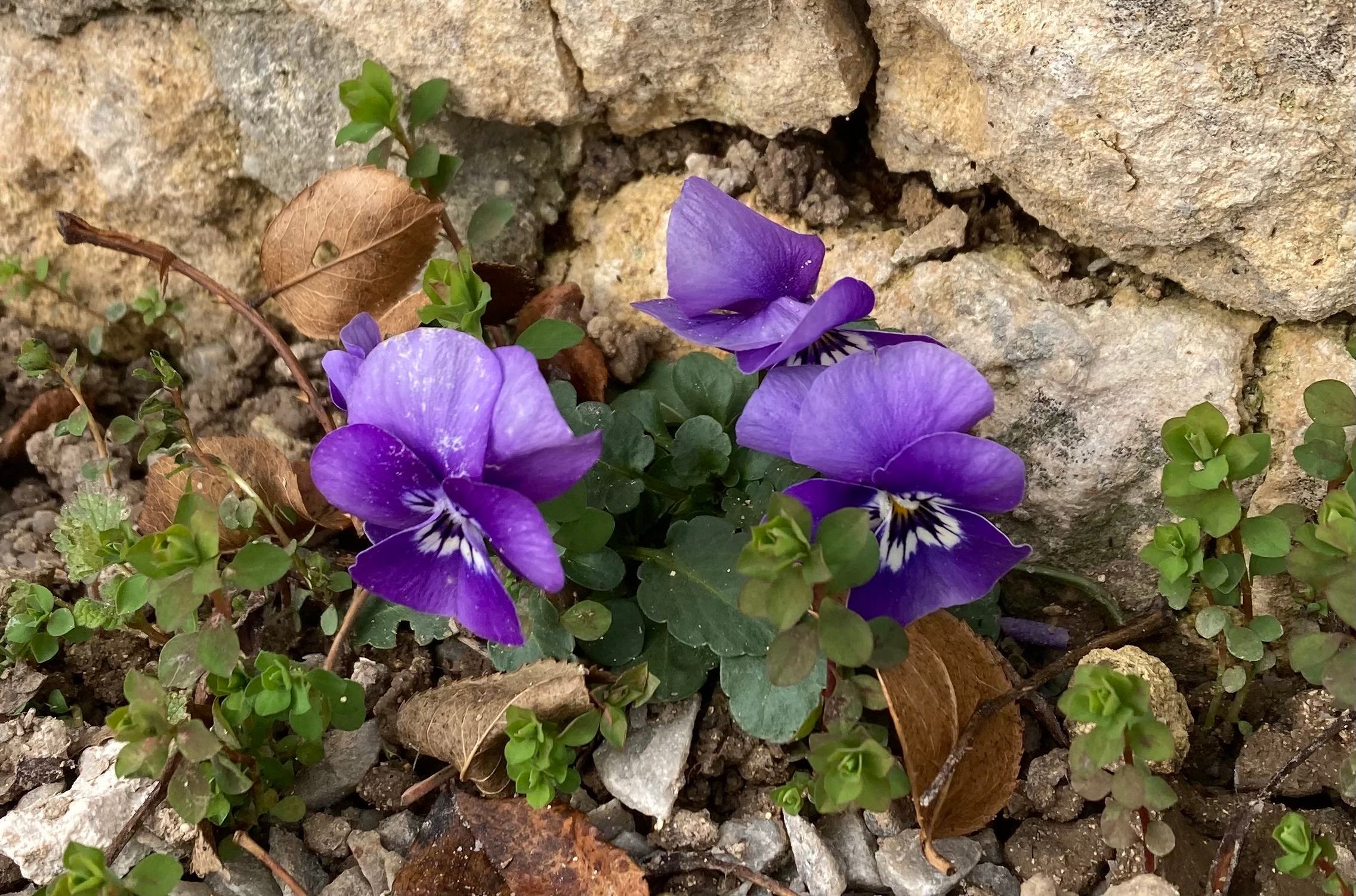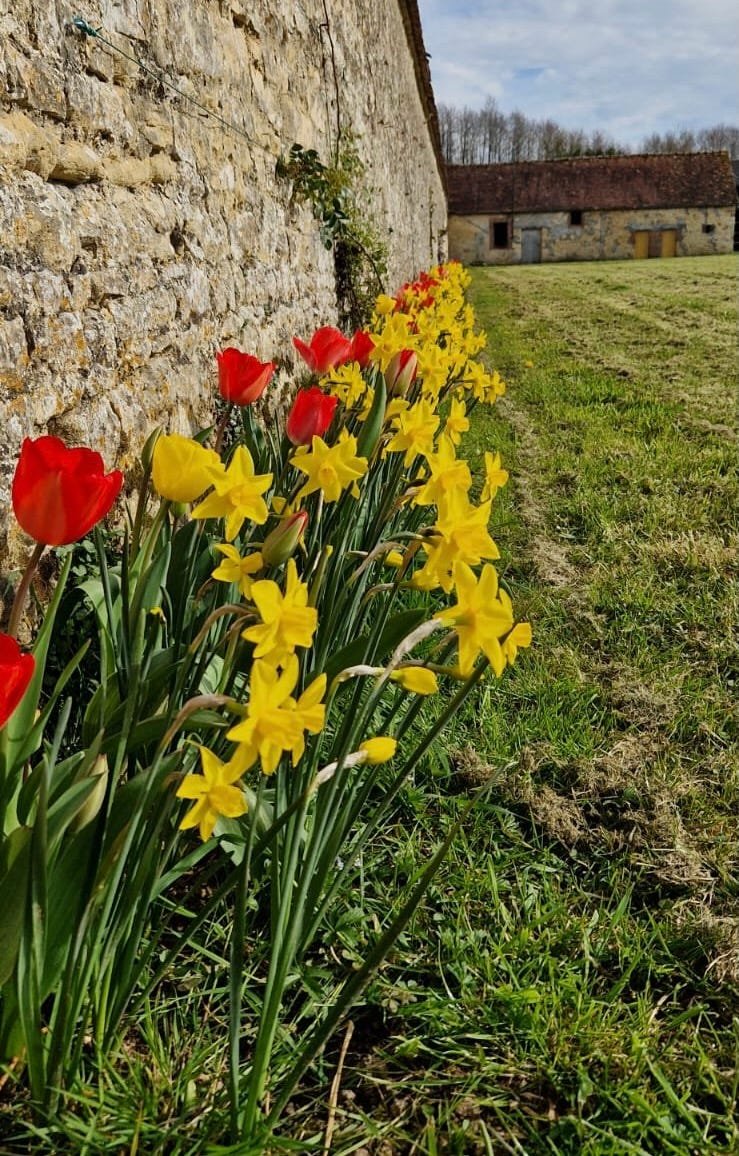Spring in the gardens of the Chateau
A steadfast plant grew all winter by the Farmhouse wall...
Chère amie, cher ami,
All winter long, the pansy bloomed beside the wall of the Maison de la Ferme at Courtomer. Its soft violet petals, touched with dark purple and black, opened upwards, offering the passerby who troubled to look earthward a moment of modest beauty.
The rest of the garden had retreated. Monsieur Martyn had cut back the perennials. He’d pruned the roses beside the moat and the espaliered pears in the walled garden. The geraniums went into one of the old box stalls. The lemon trees were behind the glass doors of the Orangerie. Drops of ice reflected in the cupped petals of spurge beside the farmhouse door.
Then, one day in February, little snowdrops appeared at the foot of the trees beside the Chateau. The pointed white buds, tightly wrapped, thrust through fallen oak leaves and curly green moss. Timidly, the first daffodils unfurled yellow petals beside the stream that cuts across the park.
With the end of March came the spring equinox. Now, at last, the sap is rising. The orchard’s first red buds showed last week. The daffodils have opened in a flurry of golden bonnets in the walled garden. And Martyn’s gaudy red tulips dance in the breeze.
The solitary pansy, just a sport from a flowerpot after all, is eclipsed by the burgeoning green world.
Monsieur Martyn’s daffodils and tulips blooming beside the wall of the basse-cour, the farmyard of the Chateau.
Yesterday was Easter.
At the nearby Cathedral of Sées, the celebration began on Friday with the veneration of the “Sainte Epine” at noon. This object -- a thorn plucked from what tradition holds is the Crown of Thorns kept at Notre-Dame de Paris -- has been in Sées since 1240. Saint Louis, king of France, brought it to the Couvent des Cordeliers there, the first Franciscan monastery in France.
Once a year, on Vendredi Saint, the faithful come up to the altar rail to venerate this holy relic of Christ’s suffering and death. In robes of white wool with red embroidered crosses, the Chevaliers, or Knights, and a few Dames of Malta and of the Saint Sepulchre provide the garde d’honneur.
A few hours later follows the ceremony of the via crucis, the Stations of the Cross. Around the nave of the Cathedral files the congregation, listening to the appropriate biblical text describing each step in the Savior’s final journey to the Cross and the tomb. In the evening, the Office de la Passion, the story of the divine sacrifice and of man’s indifference to salvation, is observed.
Saturday is dedicated to la Confession, an acknowledgement of one’s individual failings accompanied by penitence and forgiveness. One goes “forth in newness of life,” as the English Prayerbook puts it. Finally, les Pâques begins on Sunday.
At seven o’clock in the morning, a sparse but determined group gathered in the Cathedral to observe the Vigile Pascale, recalling the moment when Mary Magdalen and “the other Mary” went out to Christ’s tomb in the garden to find his body gone.
Then, at 10:30, the triumphal mass of Easter celebrated the glorious resurrection -- with its promise of divine forgiveness, rebirth in this life, and life everlasting.
Of course, swathes of Normandy did not set foot inside the Cathedral of Seés.
Nor is religious observance widespread in France. Devout Muslims are found among the immigrant North African population. There are small communities of orthodox Jews. And there are deeply traditionalist Catholics, “les tradis.”
France’s secular authorities regard such piety with suspicion. In fact, the government of Emanuel Macron has declared that private religious schools that are “hors contrat” – operating outside the canon of the state curriculum – will henceforth be closely scrutinized and possibly shut down. French children, with rare exceptions, must now attend a full-day public nursery school from the age of three.
Distrust of religious fervor has its roots in the French state’s long struggle to wrest moral authority from the Church. Louis XIV, representing the Etat back in 1682, announced he and not the Pope would personally appoint French bishops. On the absolutist principle of “Une foi, une loi, un roi” – One faith, one law, one king --he used state power to crush those who refused the religious practice endorsed by royal authority. Protestants and the mystical Catholic movement called Jansenism both fell victim to Louis’ authoritarian zeal.
Normandy’s center of Jansenism was at the Prieuré of Saint-Hymer en Auge, about an hour’s drive from the Chateau.
Louis XV and his Parlement continued the attempt to assert royal authority in matters of the spirit, although with waning success. Parisians found praying at the tomb of one popular but unofficial Jansenist saint in Paris were arrested.
“By order of the king, God may not perform miracles here!” scribbled an irreverent scoffer when the cemetery was closed. Some historians have found the origins of the French Revolution in the bitter confrontation of Protestants and Jansenists with the king and the Church.
It might seem a contradiction, but at the same time, royal power in France rested in part on the time-honored theory that a king and his dynasty were divinely appointed. The king needed a strong church to maintain legitimacy, but he preferred to control it.
The Revolution not only broke the link between king and church, it tried to stamp out the church as well. Dead kings and saints alike were dug up and unceremoniously tossed in a common pit. The Saint Ampoule, containing a holy ointment used at royal coronations since the 4th century, was publicly smashed. The church lost its property, all convents and monasteries were closed, defiant priests and nuns were killed, and Christianity was banned.
Two-thousand years of faith, piety and tradition couldn’t be eradicated so quickly, of course. The Revolution came to a halt. The Church, like a plant invigorated after severe pruning, flourished again. The story of suffering, reconciliation, pardon and rebirth continued to exercise its fascination and power.
And thus yesterday, the Cathedral of Sées filled with the faithful. There were those of a pious turn and those whose attendance might have stemmed from a sense of social rather than spiritual obligation. Les Pâques, the feast of death and resurrection, has deep roots.
As I looked for a place to tuck a chocolate egg later that morning, I happened to notice the little pansy by the Farmhouse wall. New blooms were budding forth!
Yes, the humble pansy by the Farmhouse wall is a persistent plant, too. It keeps flowering on – suggesting that rebirth is as real in nature as we hope it to be in our lives.
Joyeuses Pâques!
Elisabeth
www.chateaudecourtomer.com
On a sunny day in April…wild primroses mingle with daffodils and pheasant’s eye narcissus.




